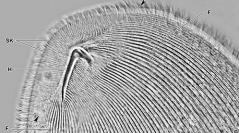

 European Journal of Taxonomy
2019 (559) - Pages 1-37
European Journal of Taxonomy
2019 (559) - Pages 1-37Four earthworm species, the endogeic Octolasion tyrtaeum (Savigny, 1826), the anecic Lumbricus terrestris Linnaeus, 1758 as well as the epigeic Eisenia fetida (Savigny, 1826) and Dendrobaena veneta (Rosa, 1886), were examined for the presence of astome ciliates. Based on the integrative taxonomic approach, five ciliate species were recognized in their gastrointestinal tracts: Metaradiophrya lumbrici (Dujardin, 1841), M. varians (de Puytorac, 1954), Anoplophrya lumbrici (Schrank, 1803), A. vulgaris de Puytorac, 1954 and A. nodulata (Dujardin, 1841). Their distinctness was assessed using the multivariate morphometric approach and molecular phylogenetic analyses. Although the two species of Metaradiophrya Jankowski, 2007 on the one hand and the two former species of Anoplophrya Stein, 1860 on the other, were not distinctly separated by the multivariate morphometric analyses, they were clearly delimited by the 18S rRNA gene sequences. Species within each genus also differed by their hosts, M. lumbrici and A. lumbrici occurred only in anecic earthworms while M. varians and A. vulgaris occured exclusively in epigeic earthworms. Only a single species, A. nodulata, was detected in endogeic earthworms. It was morphologically distinct from and did not cluster with the two other species of Anoplophrya but was nested within the paraphyletic assemblage containing other astomes from endogeic earthworms. This indicates that the evolution of endosymbiotic ciliates from earthworms has very likely proceeded through a specialization to various ecological groups of their host organisms.